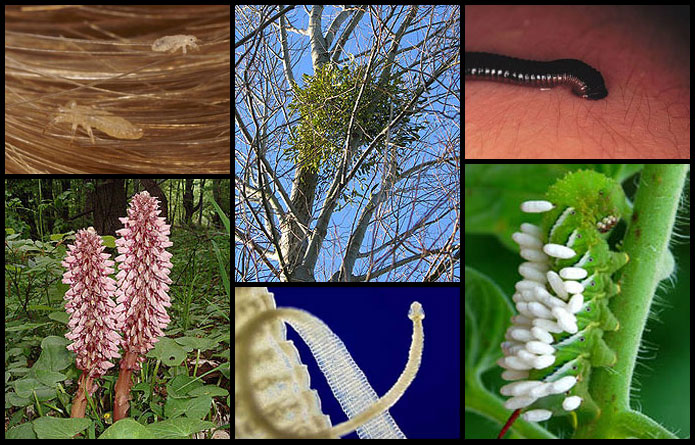
Reset

Lice are parasitic insects that must live, feed, and reproduce on the body of a living host. They can be found on a person's head and body and spread by person-to-person contact. Lice move by crawling and cannot hop or fly. They survive by feeding on human blood and cause the host to itch.
Mistletoe is a parasitic plant that grows on hardwood trees such as a live oak. The mistletoe roots grow into the tree bark and into the tissue that carries the trees' food and water. Mistletoe can harm the tree and cause the tree's branches to be deformed, but it usually does not kill the tree. Mistletoe is spread by birds and squirrels from the berries they carry in the spring time.
Leeches feed on the blood of fish, frogs, turtles, and mammals, including humans. Leeches live on rocks or leaves in a lake or stream. They detect their hosts by the vibrations they make when entering the water. The leech attaches to the host using the sucker on its mouth and another sucker located on its tail. The mouth sucker has very sharp teeth, which cut into the skin of the host. It releases a special chemical which numbs the area where the leech is feeding so the host does not feel it. The chemical also stops the host's blood from clotting so it will flow freely to the leech. Leeches can drink blood until they are about 5 times their normal body weight!
The pink flower-like structure you see here is a plant called the toothwort. The toothwort is a parasitic plant that does not have green leaves or chlorophyll. Since it has no chlorophyll, it cannot undergo photosynthesis and produce its own food. Toothwort attaches itself onto the roots of Hazel and Elm trees and takes nutrients from its host.
Tapeworms are a parasite that can grow more than 30 feet long and lay a million plus eggs a day! Tapeworms live in the intestines of humans. Cows and pigs ingest the eggs of tapeworms when they eat infected vegetation such as grass. The tapeworm burrows into the muscle of the cow or pig. Humans get tapeworms by eating undercooked beef or pork. The tapeworm consumes food and nutrients from the host's intestine. The host loses nutrients and can become very weak and sick if untreated.
The white structures on this caterpillar are the pupae of wasps. Female wasps lay eggs on the caterpillar. The eggs hatch and each young wasp burrows into the caterpillar's body. The young growing wasps eat the caterpillar for nutrients. In a short amount of time, the caterpillar will be completely consumed and will die.